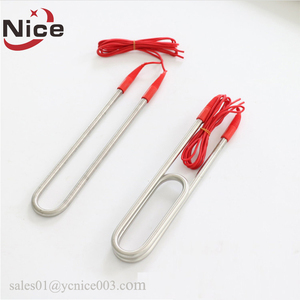
All categories
Featured selections
Trade Assurance
Buyer Central
Help Center
Get the app
Become a supplier

(1431 products available)


























To clarify the kinds of defrosting heater evaporator available for bulk buyers, a product table is shown below with additional descriptions:
Type
Foil heater
Description
A defrosting heater for evaporators with flexible, customized heating solutions. Foil heaters have even heat distribution, making them efficient for applications that need consistent heat.
K
Known for their compact construction, flexibility and lightweight properties, foil heaters are suitable for variable radiators or small limited spaces. They also have a long lifecycle with low maintenance costs.
Type
Mica round pipe heaters
Description
Defrosting heaters made for round pipe applications. They come in various lengths and wattages to fit different pipes and round evaporator needs. The heaters have a robust construction to withstand industrial environments.
K
Mica round pipe heaters are versatile as they can be mounted on several round pipes. Their consistent heating helps to prevent the formation of frost or ice, which could obstruct the pipes or negatively affect processes.
Type
Air heater
Description
A frost prevention heater for evaporators designed to heat the air directly. The aim is to prevent the build-up of frost or ice in areas with low temperatures.
K
By targeting the air, the heaters create warm air circulation that helps to keep any frost or ice from forming on coils or evaporator surfaces. This ensures many refrigeration and air conditioning systems work well.
Temperature Control:
They have temperature control systems to maintain ideal evaporator temperatures for efficient operation. These systems regulate the refrigerant and ensure the correct temperature for effective heat exchange and refrigeration.
Defrosting Mechanism:
Refrigerators have a defrosting mechanism that prevents excessive frost buildup on evaporator coils. Frost accumulation can hinder the coils' ability to absorb heat, which affects cooling efficiency. The defrosting system regularly removes ice or frost from the coils to keep them clear and ensure optimal cooling performance. The mechanism can use different methods depending on the refrigerator model. Automatic refrigerators usually have self-regulating defrosting systems that initiate periodic defrost cycles. During a defrost cycle, the compressor stops running, and the refrigerator temporarily raises its temperature to melt any accumulated ice or frost on the evaporator coils. Manual defrost models require users to initiate defrosting by turning off the compressor or pressing a defrost button at set intervals.
Power Supply:
Defrosting heater evaporators need a reliable power supply to operate the heating element for effective defrosting. They typically run on the same power supply as the refrigeration system, often 110V or 220V AC, depending on the country's electrical standards. They draw electricity to power the heating element, which generates heat during defrost cycles to melt any ice or frost on the evaporator coils.
Safety Features:
Defrosting heater evaporators have several important safety features to ensure safe operation and prevent accidents. One key feature is a thermostat, which monitors and regulates temperatures during defrost cycles to prevent overheating or excessive frost melting. The thermostats help maintain safe temperature levels and protect components from damage. In addition to the temperature control system, safety devices, and defrosting mechanisms, they also have power supply and installation requirements. Installers should follow the manufacturer's instructions when installing defrosting heater evaporators. Proper installation ensures that all safety features work effectively.
Defrosting heater evaporators have multiple usage scenarios across various industries, including refrigeration, metallurgy, and construction.
When buying a defrosting heater for an evaporator, it is important to know which one will be suitable for specific applications. There are a few tips to follow when purchasing an electric heater.
Q1: Is it possible to control the temperature of a defrosting heater?
A1: Yes, it is possible. A thermostatic control is usually used to regulate the temperature of a defrosting heater between 50 and 60°C.
Q2: How should the defrosting heater be maintained?
A2: To ensure that defrosting heaters work fine, they should be regularly checked for dirt and damage. Also, the heaters might need to be replaced after some time, depending on usage, wear, and tear.
Q3: What power supply do the different types of defrosting heaters use?
A3: Various defrosting heater types operate on different power supplys. For example, individual and multiple heater bands can operate on a power supply of 220/240V or 100/120V. However, they can also work with other voltages, depending on the specs. Immersion heaters typically operate on a 220/240V supply, but like the heater bands, they can work with other voltages based on specifications. Pipe heaters operate on either a 220/240V or a 100/120V supply similar to the heater bands. Unlike the others, self-regulating heaters use a 120V or 240V power supply.
Q4: Are there standards and approvals that defrosting heaters need to comply with?
A4: Defrosting heaters need to comply with different standards and approvals to ensure they are safe to use. The heaters have to comply with the standards and approvals pertinent to their individual specifications. Heaters that are exempt from the CE mark can be used in non-European Union countries. Manufacturers should provide documentation proving that the heaters comply with the required standards and regulations.